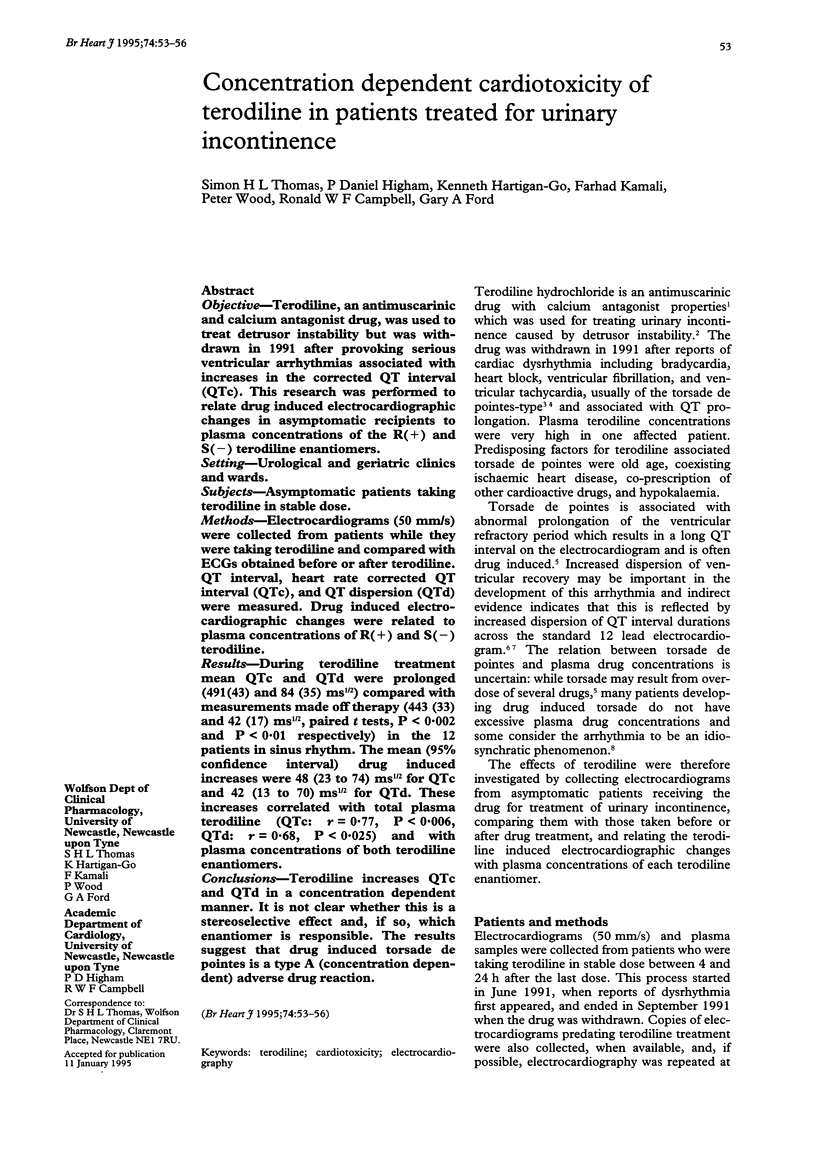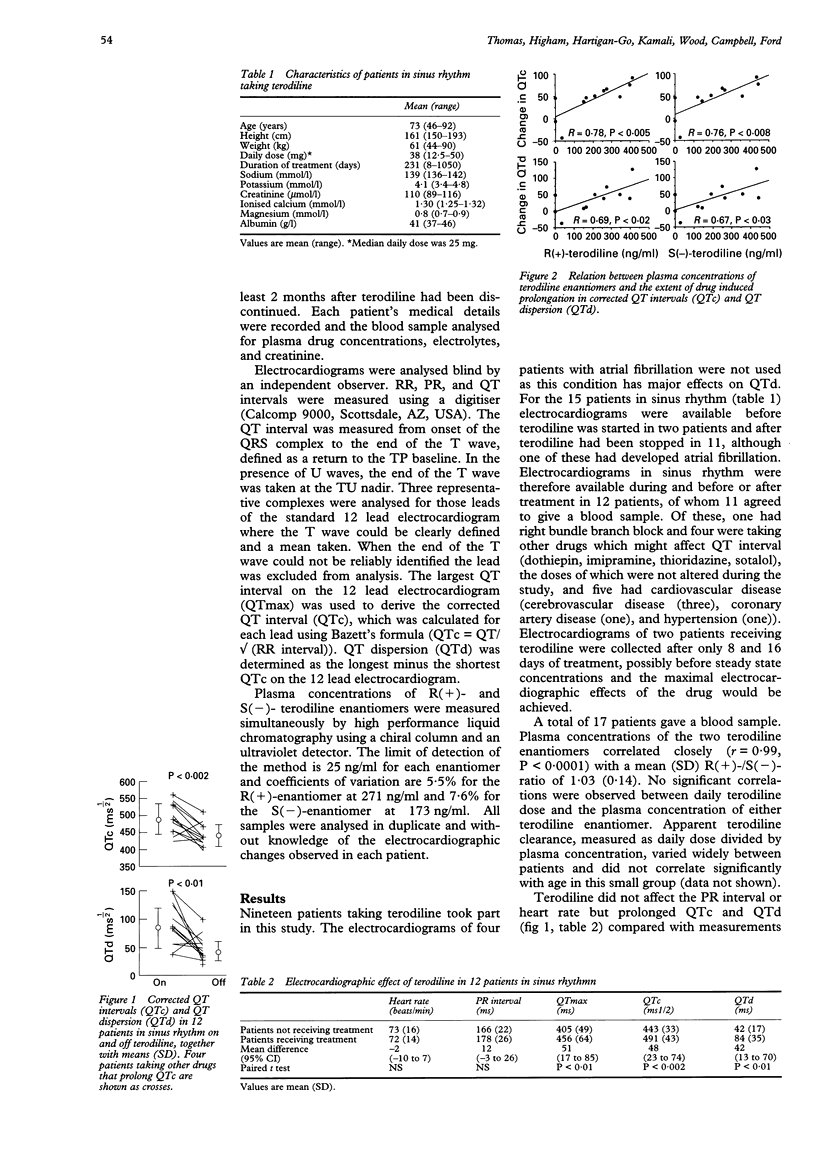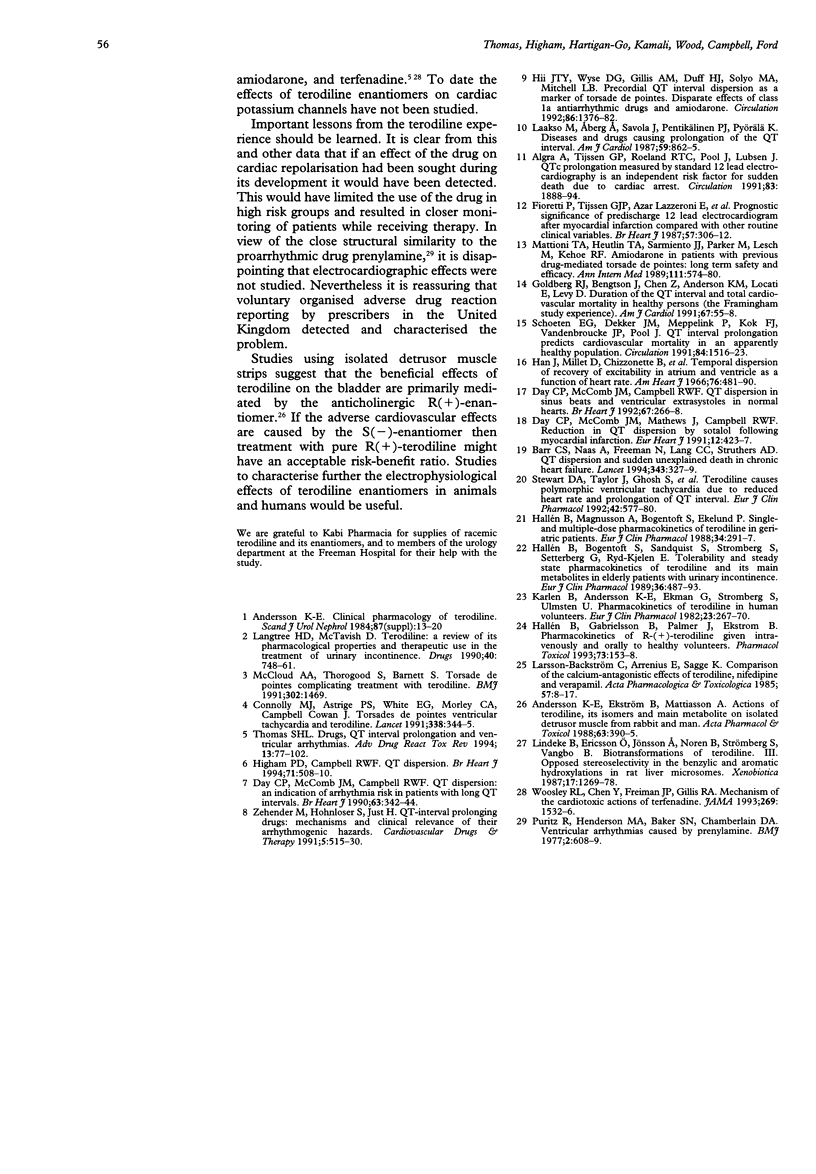Abstract
OBJECTIVE--Terodiline, an antimuscarinic and calcium antagonist drug, was used to treat detrusor instability but was withdrawn in 1991 after provoking serious ventricular arrhythmias associated with increases in the corrected QT interval (QTc). This research was performed to relate drug induced electrocardiographic changes in asymptomatic recipients to plasma concentrations of the R(+) and S(-) terodiline enantiomers. SETTING--Urological and geriatric clinics and wards. SUBJECTS--Asymptomatic patients taking terodiline in stable dose. METHODS--Electrocardiograms (50 mm/s) were collected from patients while they were taking terodiline and compared with ECGs obtained before or after terodiline. QT interval, heart rate corrected QT interval (QTc), and QT dispersion (QTd) were measured. Drug induced electrocardiographic changes were related to plasma concentrations of R(+) and S(-) terodiline. RESULTS--During terodiline treatment mean QTc and QTd were prolonged (491(43) and 84 (35) ms 1/2) compared with measurements made off therapy (443 (33) and 42 (17) ms 1/2, paired t tests, P < 0.002 and P < 0.01 respectively) in the 12 patients in sinus rhythm. The mean (95% confidence interval) drug induced increases were 48 (23 to 74) ms 1/2 for QTc and 42 (13 to 70) ms 1/2 for QTd. These increases correlated with total plasma terodiline (QTc: r = 0.77, P < 0.006, QTd: r = 0.68, P < 0.025) and with plasma concentrations of both terodiline enantiomers. CONCLUSIONS--Terodiline increases QTc and QTd in a concentration dependent manner. It is not clear whether this is a stereoselective effect and, if so, which enantiomer is responsible. The results suggest that drug induced torsade de pointes is a type A (concentration dependent) adverse drug reaction.
Full text
PDF



Selected References
These references are in PubMed. This may not be the complete list of references from this article.
- Algra A., Tijssen J. G., Roelandt J. R., Pool J., Lubsen J. QTc prolongation measured by standard 12-lead electrocardiography is an independent risk factor for sudden death due to cardiac arrest. Circulation. 1991 Jun;83(6):1888–1894. doi: 10.1161/01.cir.83.6.1888. [DOI] [PubMed] [Google Scholar]
- Andersson K. E. Clinical pharmacology of terodiline. Scand J Urol Nephrol Suppl. 1984;87:13–20. [PubMed] [Google Scholar]
- Andersson K. E., Ekström B., Mattiasson A. Actions of terodiline, its isomers and main metabolite on isolated detrusor muscle from rabbit and man. Pharmacol Toxicol. 1988 Nov;63(5):390–395. doi: 10.1111/j.1600-0773.1988.tb00974.x. [DOI] [PubMed] [Google Scholar]
- Barr C. S., Naas A., Freeman M., Lang C. C., Struthers A. D. QT dispersion and sudden unexpected death in chronic heart failure. Lancet. 1994 Feb 5;343(8893):327–329. doi: 10.1016/s0140-6736(94)91164-9. [DOI] [PubMed] [Google Scholar]
- Connolly M. J., Astridge P. S., White E. G., Morley C. A., Cowan J. C. Torsades de pointes ventricular tachycardia and terodiline. Lancet. 1991 Aug 10;338(8763):344–345. doi: 10.1016/0140-6736(91)90481-4. [DOI] [PubMed] [Google Scholar]
- Day C. P., McComb J. M., Campbell R. W. QT dispersion: an indication of arrhythmia risk in patients with long QT intervals. Br Heart J. 1990 Jun;63(6):342–344. doi: 10.1136/hrt.63.6.342. [DOI] [PMC free article] [PubMed] [Google Scholar]
- Day C. P., McComb J. M., Matthews J., Campbell R. W. Reduction in QT dispersion by sotalol following myocardial infarction. Eur Heart J. 1991 Mar;12(3):423–427. doi: 10.1093/oxfordjournals.eurheartj.a059911. [DOI] [PubMed] [Google Scholar]
- Doig J. C., McComb J. M., Reid D. S. Incessant atrial tachycardia accelerated by pregnancy. Br Heart J. 1992 Mar;67(3):266–268. doi: 10.1136/hrt.67.3.266. [DOI] [PMC free article] [PubMed] [Google Scholar]
- Goldberg R. J., Bengtson J., Chen Z. Y., Anderson K. M., Locati E., Levy D. Duration of the QT interval and total and cardiovascular mortality in healthy persons (The Framingham Heart Study experience). Am J Cardiol. 1991 Jan 1;67(1):55–58. doi: 10.1016/0002-9149(91)90099-7. [DOI] [PubMed] [Google Scholar]
- Hallén B., Bogentoft S., Sandquist S., Strömberg S., Setterberg G., Ryd-Kjellén E. Tolerability and steady-state pharmacokinetics of terodiline and its main metabolites in elderly patients with urinary incontinence. Eur J Clin Pharmacol. 1989;36(5):487–493. doi: 10.1007/BF00558074. [DOI] [PubMed] [Google Scholar]
- Hallén B., Gabrielsson J., Palmér L., Ekström B. Pharmacokinetics of R(+)-terodiline given intravenously and orally to healthy volunteers. Pharmacol Toxicol. 1993 Sep;73(3):153–158. doi: 10.1111/j.1600-0773.1993.tb01555.x. [DOI] [PubMed] [Google Scholar]
- Hallén B., Magnusson A., Bogentoft S., Ekelund P. Single- and multiple-dose pharmacokinetics of terodiline in geriatric patients. Eur J Clin Pharmacol. 1988;34(3):291–297. doi: 10.1007/BF00540958. [DOI] [PubMed] [Google Scholar]
- Higham P. D., Campbell R. W. QT dispersion. Br Heart J. 1994 Jun;71(6):508–510. doi: 10.1136/hrt.71.6.508. [DOI] [PMC free article] [PubMed] [Google Scholar]
- Hii J. T., Wyse D. G., Gillis A. M., Duff H. J., Solylo M. A., Mitchell L. B. Precordial QT interval dispersion as a marker of torsade de pointes. Disparate effects of class Ia antiarrhythmic drugs and amiodarone. Circulation. 1992 Nov;86(5):1376–1382. doi: 10.1161/01.cir.86.5.1376. [DOI] [PubMed] [Google Scholar]
- Karlén B., Andersson K. E., Ekman G., Strömberg S., Ulmsten U. Pharmacokinetics of terodiline in human volunteers. Eur J Clin Pharmacol. 1982;23(3):267–270. doi: 10.1007/BF00547566. [DOI] [PubMed] [Google Scholar]
- Laakso M., Aberg A., Savola J., Pentikäinen P. J., Pyörälä K. Diseases and drugs causing prolongation of the QT interval. Am J Cardiol. 1987 Apr 1;59(8):862–865. doi: 10.1016/0002-9149(87)91107-6. [DOI] [PubMed] [Google Scholar]
- Langtry H. D., McTavish D. Terodiline. A review of its pharmacological properties, and therapeutic use in the treatment of urinary incontinence. Drugs. 1990 Nov;40(5):748–761. doi: 10.2165/00003495-199040050-00008. [DOI] [PubMed] [Google Scholar]
- Larsson-Backström C., Arrhenius E., Sagge K. Comparison of the calcium-antagonistic effects of terodiline, nifedipine and verapamil. Acta Pharmacol Toxicol (Copenh) 1985 Jul;57(1):8–17. doi: 10.1111/j.1600-0773.1985.tb00002.x. [DOI] [PubMed] [Google Scholar]
- Lindeke B., Ericsson O., Jönsson A., Noren B., Strömberg S., Vangbo B. Biotransformation of terodiline. III. Opposed stereoselectivity in the benzylic and aromatic hydroxylations in rat liver microsomes. Xenobiotica. 1987 Nov;17(11):1269–1278. doi: 10.3109/00498258709047158. [DOI] [PubMed] [Google Scholar]
- Mattioni T. A., Zheutlin T. A., Sarmiento J. J., Parker M., Lesch M., Kehoe R. F. Amiodarone in patients with previous drug-mediated torsade de pointes. Long-term safety and efficacy. Ann Intern Med. 1989 Oct 1;111(7):574–580. doi: 10.7326/0003-4819-111-7-574. [DOI] [PubMed] [Google Scholar]
- McLeod A. A., Thorogood S., Barnett S. Torsades de pointes complicating treatment with terodiline. BMJ. 1991 Jun 15;302(6790):1469–1469. doi: 10.1136/bmj.302.6790.1469-c. [DOI] [PMC free article] [PubMed] [Google Scholar]
- Puritz R., Henderson M. A., Baker S. N., Chamberlain D. A. Ventricular arrhythmias caused by prenylamine. Br Med J. 1977 Sep 3;2(6087):608–609. doi: 10.1136/bmj.2.6087.608. [DOI] [PMC free article] [PubMed] [Google Scholar]
- Stewart D. A., Taylor J., Ghosh S., Macphee G. J., Abdullah I., McLenachan J. M., Stott D. J. Terodiline causes polymorphic ventricular tachycardia due to reduced heart rate and prolongation of QT interval. Eur J Clin Pharmacol. 1992;42(6):577–580. doi: 10.1007/BF00265918. [DOI] [PubMed] [Google Scholar]
- Thomas S. H. Drugs, QT interval abnormalities and ventricular arrhythmias. Adverse Drug React Toxicol Rev. 1994 Summer;13(2):77–102. [PubMed] [Google Scholar]
- Woosley R. L., Chen Y., Freiman J. P., Gillis R. A. Mechanism of the cardiotoxic actions of terfenadine. JAMA. 1993 Mar 24;269(12):1532–1536. [PubMed] [Google Scholar]
- Zehender M., Hohnloser S., Just H. QT-interval prolonging drugs: mechanisms and clinical relevance of their arrhythmogenic hazards. Cardiovasc Drugs Ther. 1991 Apr;5(2):515–530. doi: 10.1007/BF03029779. [DOI] [PubMed] [Google Scholar]


